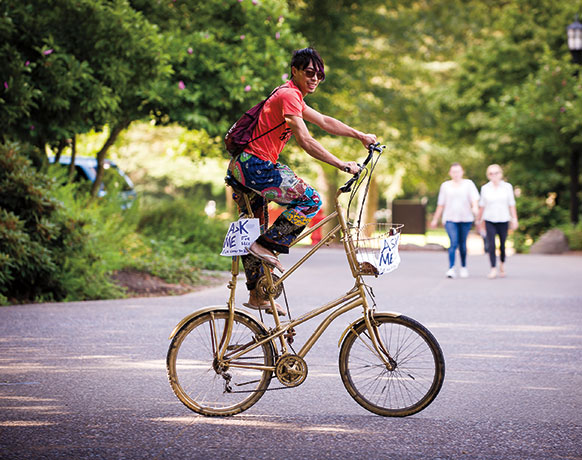
IRIS login | Reed College home Volume 91, No. 4: December 2012
Apocrypha: Traditions, Myths, & Legends
Attack of the Velocipedes

Reed’s tradition of mutant velocipedia still runs strong, as shown by Mark Angeles ’15 at Orientation 2012.
Photo by Leah Nash
CH VNK: Mutant bikes, surreal modes of conveyance, and an apocalyptic philosophy.
By Raymond Rendleman ’06
Sunday of Renn Fayre, 1993. Somebody set up a barrel fire in the Quad and started riding a bizarre contraption around it. An easy-riding, chopper-style pedaler with an extra-long fork joined in the roundabout action. Then a couple more revelers, on mutant tricycles that had certainly never seen a Toys“R”Us showroom, wound through the ankles of a gathering crowd.
Loudspeakers ground out a menacing beat supplied by KRRC. A piece of cardboard discarded from the shambles of a Great Lawn sculpture at thesis parade allowed riders to surf across the concrete when they slammed on their brakes. Their performance art piece or collective emotional release (no one ever figured out which) reached its apotheosis that day when the riders decided that an even more striking effect might be achieved if said cardboard were set on fire. Thus CHVNK, Reed’s mutant-bicycle collective, was born.
The idea germinated with Karl Anderson ’95, who in 1992 forged the first recorded tall bike in Reed’s history by asking a facilities services employee to help him weld together two bikes. (The employee’s name remains a carefully guarded secret.) Co-conspirators Al Kun ’95 and Justin Callaway ’94 were part of the core group from the very beginning. While Al had the technical know-how to weld together bikes from scrap in semi-reliable ways, Justin had the passion to plan the next wild event. Karl, who worked in Reed’s computing services as a student, became the group’s de facto spokesman by creating one of the first websites in online history and publishing Chunk zines.
From the spark set at Renn Fayre, the tight-knit group of Reedies spread their gospel of crazy fun to thousands of enthusiasts across the country. They would troll dumpsters across Portland for castaway bikes; frequent donors included the nonprofit Community Cycling Center and Citybikes, a repair collective. They were all willing to break a nose, or worse, for what an outsider might perceive as no reason in particular.
“We’ve always stated that we do it for the children—for the childlike aspects in all of us that are stupid and creative, and for all the kids who are much more likely to think it’s cool,” Karl says.
Being Reedies, they weren’t satisfied with inventing a new form of transportation; they also invented an entire mythology. Having grown up under the threat of nuclear war in the ’80s, they welded together an apocalyptic vision of a future in which survivors of a nuclear holocaust would have to jury-rig their transportation out of scraps of trash and discarded mechanical components. The hardy population would necessarily construct their human-powered transports as tall as possible to avoid poison gases, toxic soil, and explosive surfaces. A forcibly anticonsumerist environment would still allow for the production of massive amount of duct tape. The message was clear: Earth’s current population needs to practice the art of constructing, riding, and fighting such forms of transportation or expect imminent demise.
The chosen arts included jousting, time trials, last-man-standing “foot-down derbies,” and baby-rescuing contests that ended up mangling more than a few dolls. Popular jousting practices outgrew Renn Fayre, and by 2005 the number of participants at the annual “Chunkathon” exceeded 750. The organizers had tried to keep that year’s blowout a secret, but the two-wheeled hordes found their location anyway, despite a leak to Willamette Week with the wrong address. With the Chunkathons getting out of hand, organizers had to make a decision: charge admission, hire security, and create an official festival, or else go underground. The constraints of institution being anathema to their “organization,” they went subterranean, but continue to reappear for occasional expeditions or impromptu bouts of bike polo. Recent expeditions have kept Chunk-style bikers in the public eye at the Municipal Elevator in Oregon City, at an abandoned war bunker in Kelley Point Park, and on Ross Island, with “aquachoppers” lashed to empty plastic drums.


LATEST COMMENTS
steve-jobs-1976 I knew Steve Jobs when he was on the second floor of Quincy. (Fall...
Utnapishtim - 2 weeks ago
Prof. Mason Drukman [political science 1964–70] This is gold, pure gold. God bless, Prof. Drukman.
puredog - 1 month ago
virginia-davis-1965 Such a good friend & compatriot in the day of Satyricon...
czarchasm - 4 months ago
John Peara Baba 1990 John died of a broken heart from losing his mom and then his...
kodachrome - 7 months ago
Carol Sawyer 1962 Who wrote this obit? I'm writing something about Carol Sawyer...
MsLaurie Pepper - 8 months ago
William W. Wissman MAT 1969 ...and THREE sisters. Sabra, the oldest, Mary, the middle, and...
riclf - 10 months ago